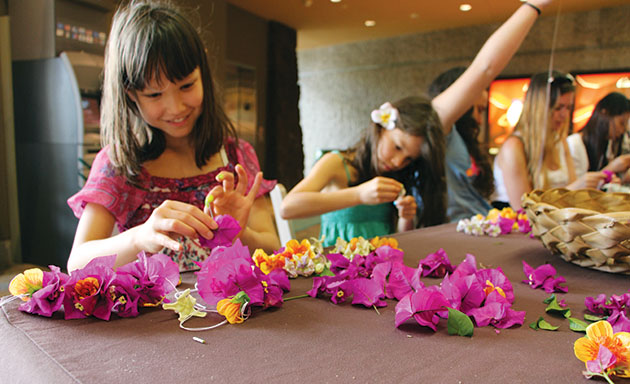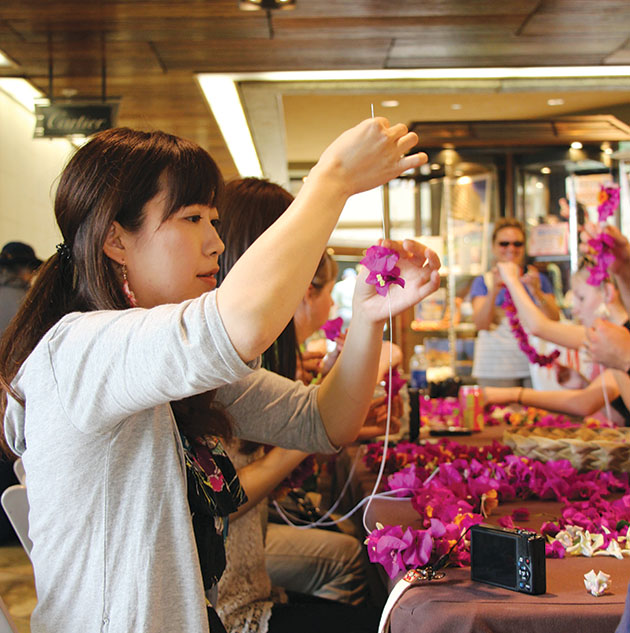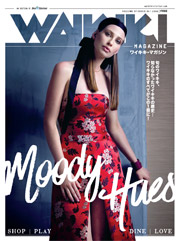Lei Aloha
Learn how to string your own lei at classes throughout Waikiki.
“A lei is the most precious gift to give or receive for Hawaiians,” explains lei maker Alexandria Kauiokeanuenue Byous to a group of 25 people gathered around her in the Royal Hawaiian Center.
The group is there for Byous’ weekly afternoon lei making class, just one of several sessions hosted at the center throughout the week. The class is free and open to the public.
Byous holds a long needle in the air, motioning for the group to do the same. Carefully, slowly, she places the needle through the center of a flower and then slides it down the string.

Lei, as Byous explains to the class, can be worn for a range of special occasions and are often gifted to people in celebration of birthdays, anniversaries or to welcome guests to the islands. But, she clarifies, a special occasion is not a prerequisite to adorn yourself or others with a lei—a lei can be worn anywhere, anytime.
“I would rather receive a lei, a beautiful lei, than a gold necklace or a gold bracelet, because that is how much meaning it has for us,” says Byous, who runs Aunty Bella’s Lei Stand, which is located on the sidewalk outside of Royal Hawaiian Center.
“All of your mana (power or energy of any living thing) is collected in a lei. And that is how the aloha spirit travels from person to person. It is very, very special,” she adds.
With baskets of ‘ilima, crown and bougainvillea flowers, the students string together vibrant, varied patterns. The class regularly attracts people from all over—and today there are students from the Mainland, Japan, Germany and Brazil. Among the class is a group of high school exchange students who are on vacation together. Their trip has been filled with hiking, surfing and visiting historical sites, but they all agreed that lei making was something they wanted to incorporate into their busy schedule.
For Alabama native Andrea Nelson, the class was one of the things she had been looking forward to the most during her trip to celebrate her 10th anniversary with husband Ryan.
“I love it,” Andrea says. “I think I will continue to do this when I get home.”
“The most beloved thing in [Hawaiian] culture is family,” says Aka Oclinaria, the cultural practitioner at Hyatt Regency Waikiki, which also offers regular lei making classes for hotel guests, and a class open to the public on Fridays. “And the circle of the lei symbolizes the family’s love that you get to wear.”
Oclinaria adds that it was customary in his family growing up to gift relatives with lei as a way to end a feud.
In ancient Hawai‘i, being a lei maker was passed down from generation to generation. The craft is still very much a family affair—both Byous and Oclinaria learned their craft from their relatives.
“In the old days … you had to be chosen by royalty,” explains Byous, whose mother, grandmother and great-grandmother all were lei makers and all previously managed the lei stand before she took over four years ago. “Just like they would choose fishermen, they would choose lo‘i farmers. You are chosen to be a lei maker.”

Because lei take on the energy of the lei maker, it is crucial that the maker maintain a positive state of mind.
“When I am making lei, I think of only good thoughts,” Byous says. “When I am gathering my flowers, I think of the person that I am going to make the lei for. That is so you are filled with good mana… We want the person who is wearing [the lei] to feel loved and to feel the aloha spirit in them.”
In addition to flowers, lei also are commonly made from permanent materials including feathers and shells. Due to the lengthy, intricate process that is required to construct a feather lei—not to mention actually gathering the feathers—these lei were reserved for ali‘i (royalty) in Native Hawaiian culture. Traditionally, feather lei feature yellow, red, green or black feathers.
Award-winning feather lei maker Boris Huang says that each lei takes him an average of about 40 hours to complete. Huang, who studied under feather lei master Aunty Mary Lou Kekuewa, creates feather lei in the traditional style, trimming and tying each feather individually. His lei, which are featured exclusively at Martin & MacArthur stores (including a location at Hilton Hawaiian Village), are comprised of up to 3,000 feathers.
“We want to keep the culture alive, so we keep the technique the same as in the past,” says Huang.
Within an hour, each student has managed to create either a head or neck lei. As they put on their finished products, the students are all smiles.
“There is something about getting a lei that just makes people happy,” Byous says.
Even when the flowers begin to wilt, this doesn’t mean the life of the lei is over. Rather, a flower lei should be given back to the land—as a way to preserve the energy that went into making it. Wilting lei can be taken into the mountains or placed near a tree. Or, lei can also be put in the ocean at sunset.
“As the sun goes down, you say your own special prayers and you float the lei out for your ancestors and loved ones,” Byous says.
Lei Making Classes
Royal Hawaiian Center
Level 1, Building A Monday – Saturday, 1-2 p.m.
Free, open to the public (808) 922-2299
Hyatt Regency Waikiki
Great Hall (by the waterfall) Friday, 4:30-6 p.m.
Free, open to the public (808) 923-1234
Note: A number of hotels throughout Waikiki also offer lei making classes for guests only. Check with your hotel about classes.
Photos: Christina O’Connor









